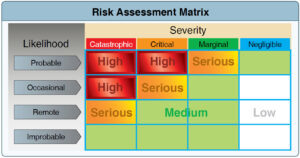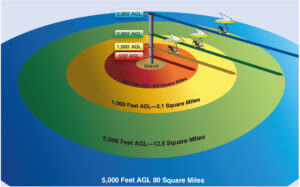Modern Trikes Weight Shift Control Light-Sport Aircraft (LSA)
Most modern trikes are built to strict airworthiness standards. If maintained and pre-flighted properly as every pilot is trained, there is very little chance of a mechanical malfunction. In fact, very few accidents occur because of mechanical failure. It must be noted that some home-built, experimentals and/or the old ultralights are not as airworthy and should be looked at carefully and in great detail by qualified aircraft mechanic with experience in WSC trikes before flying.
Most modern trikes are safer than regular airplanes because many have a ballistic parachute system installed. This greatly increases the safety above and beyond regular airplanes. If there is a serious mechanical failure or weather-related situation, the pilot simply becomes incapacitated or you have an engine failure over hostile terrain, the emergency parachute can be deployed and the aircraft and occupants float safely down to earth.
You need at least 300 feet above the ground to successfully deploy a ballistic parachute (note there are varying views on how high you can deploy a ballistic parachute). A ballistic parachute adds another layer of safety to flying WSC Trikes.
Other reasons sport pilots flying trikes are safer than regular airplanes are because most are flying for fun rather than under pressure to “get somewhere”. Sport pilots simply say “I’m not going to fly today because of … (some good reason) …”. This is a safety attitude which is acceptable and admired by pilots and passengers. This is a new safety age for flying.
What is safe in life?
Let’s look at safety in general. Let’s start with some things we do every day.
- Is driving safe?
- Is riding a bicycle safe?
- Is skiing safe?
- Is riding a horse safe?
- Is boating safe?
- Is riding a motorcycle safe?
Based on the number of people who die every year at the above activities, it would be “safe” to say that none of the above is safe, but we do them anyway and accept the risk.
Why are they unsafe and people get hurt? Mainly because the driver/operator decision and/or other controlled or uncontrolled events such as other people causing the accident. Luckily, for aviation, there is much less chance of others causing an accident with all the room in the sky.
Engine Failure and Risk Analysis
A common statement when someone sees a powered hang glider/weight-shift control trike in a picture without any suitable landing in the picture: I would never fly without a suitable landing area within a gliding distance.
Why does this thought/concept typically come up with WSC trike pilots and not airplane pilots? It is simple, the historical evolution of both were significantly different.
A look at recent history
• 30 years ago, airplane pilots were flying certified airplanes such as Cessna or Pipers and there were reasonably reliable with very few engine failures.
• 30 years ago, trikes were flying unproven, unreliable and poorly designed two strokes and there were plenty of engine failures and almost everyone had one.
This “primacy” Principal of Learning from early instructors has stuck around and has been passed along from instructor to instructor to student for years. It is not a bad perspective and a good one to have in ANY AIRCRAFT. As a matter of fact, there are still plenty of old unreliable two strokes out there. So generally, all trikes are grouped together and deemed unreliable.
Additionally, “ultralights”, airplanes and WSC trikes, also fit into this category of unreliable over history and also fit into this unreliable “group”. However this general misrepresentation will be discussed in this article with a new generation of ASTM certificated S-LSA.
Basics of two stroke verses four stroke reliability
If you compare a two-stroke experimental E-LSA engine to a four stroke ASTM certified S-LSA engine system, there is a significant difference in reliability. To give the two stroke experimental some credit, I did run five separate two stroke engines for over 2000 hours and they all ran perfectly. Why? Because I made sure the design/installation was per manufacturers specifications (Rotax) and took great care in operating/maintaining/feeding them.
My statement about two stroke reliability: “Two stroke engines do not quit, they are murdered” is true. They simply need more attention and awareness in operation. Overall, it is common knowledge that a two stroke is less reliable than a four stroke for many reasons. This is a first step in understating engine reliability. What type or engine do you have?
You and reliability today
You have a choice as to how reliable your propulsion system will be. Note we say Propulsion system because the engine is a part of the complete propulsion system including the most important FUEL SUPPLY and propeller. If you buy/fly an old poorly designed system with a two stroke and do not operate/maintain/feed it properly, chances are probable it will quit in flight. If you buy a new certificated S-LSA WSC Trike and you maintain/operate and feed it properly, it will run as reliably as a certificated airplane.
Thousands of airplanes fly over unlandable terrain daily (cities, forests, oceans). Private pilots fly at night where they cannot see any suitable landing area most of the time. Thousands per day. They/we all think about engine outs same as trikes but FAA certificated airplanes and S-LSA trikes are pretty reliable.
Note that the federal regulation FAR 91.319 (c) for ALL Experimental aircraft (including airplanes and WSC Trike) does not allow operation, unless specifically authorized, over densely populated areas. The FAA has determined ANY Experimental aircraft, airplane or WSC Trike, to be less reliable than FAA certified airplanes per FAR Part 21 AND certified S-LSA trikes per FAR 91.327.
In summary, there is a huge variance in reliability for aircraft powerplants. Now let’s look at using common sense to determine the risk.
Risk Analysis
Knowing the fact is that there is a huge range of likelihood of an engine failure, let’s look at the basic Risk Analysis for propulsion system failure.  Note there is risk categories of Low, Medium, Serious and High. Simply low being low risk and high being high risk. Overall, we try to lower our risk. Some risk in most activities can not be eliminated. This is the foundation for pilot training and for all aspects of life in general. From the Risk Assessment Matrix, we see that this likelihood of engine failure can range from probable to improbable and two likelihoods in between. Old two stroke not maintained/operated properly is a probable powerplant failure, and new S-LSA four stroke Improbable or Remote as you wish to classify it.
Note there is risk categories of Low, Medium, Serious and High. Simply low being low risk and high being high risk. Overall, we try to lower our risk. Some risk in most activities can not be eliminated. This is the foundation for pilot training and for all aspects of life in general. From the Risk Assessment Matrix, we see that this likelihood of engine failure can range from probable to improbable and two likelihoods in between. Old two stroke not maintained/operated properly is a probable powerplant failure, and new S-LSA four stroke Improbable or Remote as you wish to classify it.
We have talked about the likelihood above so let’s talk about the severity. If you only fly where you always have an easy landing area within gliding distance your risk will be low unless there is a probable likelihood of an engine failure, then your risk becomes medium. I would say that if you have no ballistic parachute AND you are flying over unlandable terrain such as open water, forests or congested areas, the severity would be catastrophic. In this unlandable terrain, I would say if you have a ballistic parachute your severity would go down to critical, some might say marginal. These categories are open to different opinions/interpretations.
Let’s look at the facts. Are you always 100% within an easy and perfect landing area? More than likely the true answer is probably not. Even if you are staying in the pattern, that climb out on takeoff and turn to cross wind, Maybe you are within safe and easy gliding distance 95% of the time but 100% of the time, not likely. When you fly cross country, even if you can see landing areas, some of which look good from up high but typically get worse as you get closer ready to land. Maybe on a cross country of you are vigilant and plan it out, you may have good easy to reach landing areas 80% of the time. Most serious cross-country flights you will have viable landing areas plus or minus 50% of the time. If you want to minimize your severity with a propulsion system failure you are simply working with minimizing the percentage of time you do not have a suitable landing area. For any aircraft, it is simply trying to reduce the percentage of time you do not have a suitable landing area. Simple numbers. Generally, with a more reliable propulsion system, your overall risk analysis is better.
Overall we try and minimize the percentage of time we do not have a suitable landing area and do our best to have a reliable propulsion system. Both these create a better risk analysis.
Note that the higher you fly above ground level, the area you have for a suitable landing area increases quickly (exponentially).
 Summary – Engine Failure Risk Analysis
Just like all aspects in life, we need to do a risk analysis for the complete flight which includes this item for an engine failure. Although the propulsion system reliability and flight location severity is important and is important based on what we have talked about above, the other aspects of flight need to be also be evaluated to perform an overall risk analysis for every flight. As we stress in our pilot training, look at the PAVE (Pilot, Aircraft, enVironment, External pressures) checklist for a complete Risk analysis. Here we have looked at the Aircraft (reliability) and the enVironment (location of the aircraft in relation to a suitable landing area).
Summary – Engine Failure Risk Analysis
Just like all aspects in life, we need to do a risk analysis for the complete flight which includes this item for an engine failure. Although the propulsion system reliability and flight location severity is important and is important based on what we have talked about above, the other aspects of flight need to be also be evaluated to perform an overall risk analysis for every flight. As we stress in our pilot training, look at the PAVE (Pilot, Aircraft, enVironment, External pressures) checklist for a complete Risk analysis. Here we have looked at the Aircraft (reliability) and the enVironment (location of the aircraft in relation to a suitable landing area). 